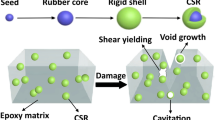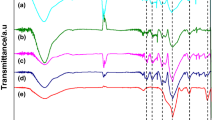Abstract
Rubber has a wide range of application prospects as an important material in the field of oil extraction and sealing rings. The effect of molybdenum disulfide (2H-MoS2) on the properties of the composites of antioxidant 4020 and nitrile butadiene rubber (NBR) was investigated. Two sets of composites, 4020/NBR and MoS2/4020/NBR, were modeled using molecular dynamics simulations. The mechanical, thermal-oxidative aging and tribological properties of 2H-MoS2 on NBR composites were investigated at 298 and 398 K, respectively, and the adsorption ability and reinforcement effect of 2H-MoS2 on NBR were analyzed from an atomic perspective. The mechanical studies showed that Young’s modulus of MoS2/4020/NBR composites was improved by about 28% and 23% compared with 4020/NBR composites at 298 and 398 K temperatures, respectively. Therefore, the mechanical properties of NBR composites were significantly improved by the addition of MoS2. Similarly, the properties such as solubility parameters, mean square displacement, and binding energy of MoS2/4020/NBR composites were improved, and the stability and thermal and oxygen aging properties of NBR composites were effectively improved after the addition of MoS2. Tribological studies also showed that the friction coefficients of MoS2/4020/NBR composites were reduced by about 30% and 25%, and the wear rates were reduced by 5% and 7% at 298 and 398 K, respectively, compared with those of 4020/NBR composites. Therefore, MoS2 successfully enhances the tribological characteristics of NBR composites.







Similar content being viewed by others
Data availability
Data will be made available on request.
References
A.E. Jahromi, H.R.E. Jahromi, F. Hemmati et al., Morphology and mechanical properties of polyamide/clay nanocomposites toughened with NBR/NBR-g-GMA: a comparative study. Compos. B Eng. 90, 478–484 (2016). https://doi.org/10.1016/j.compositesb.2015.12.042
D. Feng, M.-X. Shen, X.-D. Peng et al., Surface roughness effect on the friction and wear behaviour of acrylonitrile-butadiene rubber (NBR) under oil lubrication. Tribol. Lett. 65, 10 (2017). https://doi.org/10.1007/s11249-016-0793-5
J. Liu, X. Li, L. Xu et al., Investigation of aging behavior and mechanism of nitrile-butadiene rubber (NBR) in the accelerated thermal aging environment. Polym. Testing 54, 59–66 (2016). https://doi.org/10.1016/j.polymertesting.2016.06.010
X. Zhai, Y. Chen, D. Han et al., New designed coupling agents for silica used in green tires with low VOCs and low rolling resistance. Appl. Surf. Sci. 558, 149819 (2021). https://doi.org/10.1016/j.apsusc.2021.149819
C. Zhang, T. Wang, W. Sun, C. Li, H. Zhao, Grafting of antioxidant onto polyethylene to improve DC dielectric and thermal aging properties. IEEE Trans. Dielectr. Electr. Insul. 28(2), 541–549 (2021). https://doi.org/10.1109/TDEI.2020.009261
B. Zhong, H. Dong, Y. Luo et al., Simultaneous reduction and functionalization of graphene oxide via antioxidant for highly aging resistant and thermal conductive elastomer composites. Compos. Sci. Technol. 151, 156–163 (2017). https://doi.org/10.1016/j.compscitech.2017.08.019
G.H. Jeong, S.P. Sasikala, T. Yun et al., Nanoscale assembly of 2D materials for energy and environmental applications. Adv. Mater. 32(35), 1907006 (2020). https://doi.org/10.1002/adma.201907006
S. Imani Yengejeh, J. Liu, S.A. Kazemi et al., Effect of structural phases on mechanical properties of molybdenum disulfide. ACS Omega 5(11), 5994–6002 (2020). https://doi.org/10.1021/acsomega.9b04360
R. Fiel, I.D. Barcelos, E.R. Leite, Organo-functionalized MoS2 as a nanofiller to enhance and control the swelling behavior of polybutadiene rubber nanocomposites. Compos. Commun. 30, 101053 (2022). https://doi.org/10.1016/j.coco.2021.101053
Z. Tang, C. Zhang, Q. Wei et al., Remarkably improving performance of carbon black-filled rubber composites by incorporating MoS2 nanoplatelets. Compos. Sci. Technol. 132, 93–100 (2016). https://doi.org/10.1016/j.compscitech.2016.07.001
C. Yi, C. Hu, M. Bai et al., Molecular dynamics study on the mechanical properties of multilayer MoS2 under different potentials. Nanotechnology 31(21), 215703 (2020)
Y. Peng, Z. Ni, Tribological properties of stearic acid modified multi-walled carbon nanotubes in water. J. Tribol.-Trans. ASME (2013). https://doi.org/10.1115/1.4007676
Y. Li, Z. Man, X. Lin et al., Role of well-dispersed carbon nanotubes and limited matrix degradation on tribological properties of flame-sprayed PEEK nanocomposite coatings. J. Tribol.-Trans. ASME (2022). https://doi.org/10.1115/1.4050733
B. Chen, S. Liang, S. Lu et al., Tribological properties of multi-walled carbon nanotube-Cr and graphene oxide-Cr composite coating. J. Tribol.-Trans. ASME (2019). https://doi.org/10.1115/1.4043066
R. Singh, C. Sarkar, Characterization of magnetorheological brake in shear mode using high-strength MWCNTs and fumed silica-based magnetorheological fluids at low magnetic fields. J. Tribol.-Trans. ASME (2023). https://doi.org/10.1115/1.4056042
Y. Li, S. Wang, B. Arash et al., A study on tribology of nitrile-butadiene rubber composites by incorporation of carbon nanotubes: molecular dynamics simulations. Carbon 100, 145–150 (2016). https://doi.org/10.1016/j.carbon.2015.12.104
B. Yang, S. Wang, Z. Song et al., Molecular dynamics study on the reinforcing effect of incorporation of graphene/carbon nanotubes on the mechanical properties of swelling rubber. Polym. Testing 102, 107337 (2021). https://doi.org/10.1016/j.polymertesting.2021.107337
T. Förster, Prediction of in-service NBR properties by TG-IR after storage in mineral oil, in Properties and characterization of modern materials. ed. by A. Öchsner, H. Altenbach (Springer, Singapore, 2017), pp.399–411. https://doi.org/10.1007/978-981-10-1602-8_31
F. Wang, H. Wang, Z. Wang et al., Study on properties of hydrogenated nitrile butadiene rubber filled with polyaniline compound silica. Polym. Compos. (2022). https://doi.org/10.1002/pc.26788
Y. Fu, C. Yang, Y.M. Lvov et al., Antioxidant sustained release from carbon nanotubes for preparation of highly aging resistant rubber. Chem. Eng. J. 328, 536–545 (2017). https://doi.org/10.1016/j.cej.2017.06.142
N. Vu-Bac, M.A. Bessa, T. Rabczuk et al., A multiscale model for the quasi-static thermo-plastic behavior of highly cross-linked glassy polymers. Macromolecules 48(18), 6713–6723 (2015)
N. Vu-Bac, P.M.A. Areias, T. Rabczuk, A multiscale multisurface constitutive model for the thermo-plastic behavior of polyethylene. Polymer 105, 327–338 (2016)
N. Vu-Bac, T. Lahmer, H. Keitel et al., Stochastic predictions of bulk properties of amorphous polyethylene based on molecular dynamics simulations. Mech. Mater. 68, 70–84 (2014)
N. Vu-Bac, X. Zhuang, T. Rabczuk, Uncertainty quantification for mechanical properties of polyethylene based on fully atomistic model. Materials 12(21), 3613 (2019)
X. Wang, D. Chen, W. Zhong et al., Experimental and theoretical evaluations of the interfacial interaction between carbon nanotubes and carboxylated butadiene nitrile rubber: mechanical and damping properties. Mater. Des. 186, 108318 (2020). https://doi.org/10.1016/j.matdes.2019.108318
Q. Wei, Y. Wang, Y. Rao et al., Evaluating the effects of nanosilica on mechanical and tribological properties of polyvinyl alcohol/polyacrylamide polymer composites for artificial cartilage from an atomic level. Polymers 11(1), 76 (2019). https://doi.org/10.3390/polym11010076
Y. Shang, J. Wen, Y. Dong et al., Luminescence properties of PbS quantum-dot-doped silica optical fibre produced via atomic layer deposition. J. Lumin. 187, 201–204 (2017). https://doi.org/10.1016/j.jlumin.2017.03.009
A.S. Sethulekshmi, J.S. Jayan, S. Appukuttan et al., MoS2: advanced nanofiller for reinforcing polymer matrix. Phys. E 132, 114716 (2021). https://doi.org/10.1016/j.physe.2021.114716
W. Song, J. Yan, H. Ji, Fabrication of GNS/MoS2 composite with different morphology and its tribological performance as a lubricant additive. Appl. Surf. Sci. 469, 226–235 (2019). https://doi.org/10.1016/j.apsusc.2018.10.266
A.S. Pavlov, P.G. Khalatur, Filler reinforcement in cross-linked elastomer nanocomposites: insights from fully atomistic molecular dynamics simulation. Soft Matter 12(24), 5402–5419 (2016). https://doi.org/10.1039/C6SM00543H
Y.R. Liang, H.X. Yang, Y.J. Tan et al., Mechanical and tribological properties of nitrile rubber filled with modified molybdenum disulphide. Plast. Rubber Compos. 45(6), 247–252 (2016). https://doi.org/10.1080/14658011.2016.1178968
S. Baghel, H. Cathcart, N.J. O’Reilly, Polymeric amorphous solid dispersions: a review of amorphization, crystallization, stabilization, solid-state characterization, and aqueous solubilization of biopharmaceutical classification system class II drugs. J. Pharm. Sci. 105(9), 2527–2544 (2016). https://doi.org/10.1016/j.xphs.2015.10.008
C.Y. Tsai, S.Y. Lin, H.C. Tsai, Butyl rubber nanocomposites with monolayer MoS2 additives: structural characteristics, enhanced mechanical, and gas barrier properties. Polymers 10(3), 238 (2018). https://doi.org/10.3390/polym10030238
E. Hu, E. Su, Y. Chen et al., Preparation and tribological behaviors of modified rice husk carbon/MoS2 composite particles as a functional additive in polyethylene glycol. Tribol Trans. (2022). https://doi.org/10.1080/10402004.2022.2052213
J. Cui, J. Zhao, S. Wang et al., A comparative study on enhancement of mechanical and tribological properties of nitrile rubber composites reinforced by different functionalized graphene sheets: molecular dynamics simulations. Polym. Compos. 42(1), 205–219 (2021). https://doi.org/10.1002/pc.25819
J.I. Kim, J.W. Kim, S.H. Ryu, Wear characteristics of exfoliated MoS2/polyamide-6, 6 composite. J. Elastomers Plast. 54(2), 374–384 (2022). https://doi.org/10.1177/00952443211047072
Y. Luo, R. Wang, W. Wang et al., Molecular dynamics simulation insight into two-component solubility parameters of graphene and thermodynamic compatibility of graphene and styrene butadiene rubber. J. Phys. Chem. C 121(18), 10163–10173 (2017). https://doi.org/10.1021/acs.jpcc.7b01583
P. Weng, Q. Wei, Z. Tang et al., The influence of molybdenum disulfide nanoplatelets on the dispersion of nano silica in natural rubber composites. Appl. Surf. Sci. 359, 782–789 (2015). https://doi.org/10.1016/j.apsusc.2015.10.172
B. Arash, Q. Wang, V.K. Varadan, Mechanical properties of carbon nanotube/polymer composites. Sci. Rep. 4(1), 1–8 (2014). https://doi.org/10.1038/srep06479
C. He, X. She, Z. Peng et al., Graphene networks and their influence on free-volume properties of graphene–epoxidized natural rubber composites with a segregated structure: rheological and positron annihilation studies. Phys. Chem. Chem. Phys. 17(18), 12175–12184 (2015). https://doi.org/10.1039/C5CP00465A
R.K. Upadhyay, A. Kumar, Effect of humidity on the synergy of friction and wear properties in ternary epoxy-graphene-MoS2 composites. Carbon 146, 717–727 (2019). https://doi.org/10.1016/j.carbon.2019.02.015
D.N. Sangeetha, M. Selvakumar, Active-defective activated carbon/MoS2 composites for supercapacitor and hydrogen evolution reactions. Appl. Surf. Sci. 453, 132–140 (2018). https://doi.org/10.1016/j.apsusc.2018.05.033
D. Vikraman, S. Hussain, M. Ali et al., Theoretical evaluation and experimental investigation of layered 2H/1T-phase MoS2 and its reduced graphene-oxide hybrids for hydrogen evolution reactions. J. Alloy. Compd. 868, 159272 (2021). https://doi.org/10.1016/j.jallcom.2021.159272
R. Zhang, Y. Qin, P. Liu et al., How does molybdenum disulfide store charge: a minireview. Chemsuschem 13(6), 1354–1365 (2020). https://doi.org/10.1002/cssc.201903320
R.J. Toh, Z. Sofer, J. Luxa et al., 3R phase of MoS2 and WS2 outperforms the corresponding 2H phase for hydrogen evolution. Chem. Commun. 53(21), 3054–3057 (2017). https://doi.org/10.1039/C6CC09952A
S.J. Eder, A. Vernes, G. Betz, On the Derjaguin offset in boundary-lubricated nanotribological systems. Langmuir 29(45), 13760–13772 (2013). https://doi.org/10.1021/la4026443
C. Qian, Y. Li, J. Zhao et al., Thermal-oxidative aging and tribological properties of carbon nanotube/nitrile butadiene rubber composites with varying acrylonitrile content: molecular dynamics simulations. Polym. Eng. Sci. 63(5), 1516–1527 (2023). https://doi.org/10.1002/pen.26302
Y. Fukahori, P. Gabriel, H. Liang et al., A new generalized philosophy and theory for rubber friction and wear. Wear 446, 203166 (2020). https://doi.org/10.1016/j.wear.2019.203166
Funding
This research was funded by financial support from the Natural Science Foundation of Liaoning Province (2022-BS-176), Basic Research Project of Education Department of Liaoning Province (LJKMZ20220457).
Author information
Authors and Affiliations
Contributions
Cheng Qian: Conceptualization, Methodology, Software, Visualization, Writing-original draft, Writing—review and editing, Funding acquisition. Jichi Che: Supervision. Shijie Wang: Resources, Writing—review and editing, Supervision. Mengjia Wang: Methodology, Visualization, Writing-original draft, Software. Shuyuan Song: Writing—review and editing.
Corresponding author
Ethics declarations
Conflict of interest
The authors declare that they have no conflicts of interest to report regarding the present study.
Additional information
Publisher's Note
Springer Nature remains neutral with regard to jurisdictional claims in published maps and institutional affiliations.
Rights and permissions
Springer Nature or its licensor (e.g. a society or other partner) holds exclusive rights to this article under a publishing agreement with the author(s) or other rightsholder(s); author self-archiving of the accepted manuscript version of this article is solely governed by the terms of such publishing agreement and applicable law.
About this article
Cite this article
Qian, C., Chen, J., Wang, S. et al. Molecular dynamics investigation on the thermal-oxidative aging and mechanical properties of nitrile butadiene rubber composites with molybdenum disulfide. Appl. Phys. A 130, 256 (2024). https://doi.org/10.1007/s00339-024-07419-5
Received:
Accepted:
Published:
DOI: https://doi.org/10.1007/s00339-024-07419-5




